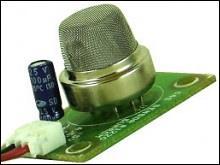In this tutorial, we are going to see a Gas Leakage Detection System using 8051.
Table of Contents
Gas Leakage Detection System using 8051
Abstract
Gas leakage tragedies and accidents have led to heavy losses over the years. So it is very important to detect any gas leakage and prevent any accidents. So here we propose a system to detect LPG gas leakage scenarios and provide a security alert to intended users.
SMS-based LPG gas leakage detection system using GSM has application in various areas like home, industries, hotels, hospitals. This project has a gas leakage detector implemented by using an LPG Gas sensor. The user can get remote indication through SMS sent from the project. This SMS is sent from the GSM modem which is connected to the microcontroller. A buzzer is turned on after LPG gas leakage so it acts as a gas leakage alarm.
Components Required
- 8051 Development board
- LCD Module
- GSM Module
- Gas Sensor
- Buzzer
- ADC0804
- Relay
Software Required
- Keil IDE
Prerequisites
Before seeing the code, first you can see the basic interfacing tutorials of these components.
- LCD Interfacing with 8051
- GSM Interfacing with 8051
- Relay Interfacing with 8051
- ADC0804 Interfacing with 8051
Block Diagram
|
|
|
Explanation
- A gas sensor is used to detect the Gas, which is connected to 8051 microcontrollers through ADC0804.
- LCD is used to Display the Gas level and Relay status.
- GSM is used to send the message when it detects the Gas in-room or home.
- The buzzer also makes a sound when the controller detects any Gas.
- Relay also connected to Micro Controller. The house’s electricity power will go through this relay. When it detects gas leakage, the relay goes off. So house electricity will be off. It will prevent the other damages by electricity.
Circuit Diagram
LCD:
- RS – P3.7
- RW – GND
- EN – P3.6
- Data lines – P1
Gas Sensor:
- Output – ADC’s Vin (6th Pin)
ADC0804:
- RD – P0.7
- WR – P0.6
- INTR – P0.5
- CS – GND
- Data Lines – P2
GSM:
- GSM RX – P3.1
- GSM TX – P3.0
Buzzer: P0.1
|
|
|
Relay: P0.0
Code
Here I’ve added only the main code. Header files are not here. You can download the full code Here.
#include<reg52.h>
#include"LCD.h" //rs=p3.7, en=p3.6
#include"GSM.h"
#define NUM "1234567890" //Enter Your Mobile Number
sbit rd=P0^7;
sbit wr=P0^6;
sbit intr=P0^5;
sbit RELAY=P0^0;
sbit buzz=P0^1;
unsigned char h,msgq;
unsigned int s,r;
void adc();
unsigned char adc_data=0;
void main()
{
init_serial();
LCD_initialise();
RELAY=1; //relay on
buzz=0; //buzz on
comwrt(0x80);
display("LOADING.");
for(h=0;h<8;h++) {
datawrt('.');
for(s=0;s<30000;s++);
}
P2=0xFF;
comwrt(0x80);
display("GAS:000PPM R:OFF");
buzz=0;
for(r=0;r<=10000;r++);
while(1) {
adc();
for(r=0;r<=20000;r++);
}
}
void adc()
{
wr=0;
rd=1;
wr=1;
while(intr==1);
rd=0;
adc_data = P2 ;
msgq = adc_data;
comwrt(0x84);
datawrt((msgq/100)+0x30);
datawrt(((msgq/10)%10)+0x30);
datawrt((msgq%10)+0x30);
if(msgq > 80) {
RELAY=0; //relay off
buzz=0; //buzz on
comwrt(0x8D);
display("OFF");
comwrt(0xC0);
display("G:HIGH V:CLOSE");
for(s=0;s<60000;s++);
comwrt(0xC0);
display("SENDING MSG.....");
sendSMS(NUM,"VOLVE CLOSED AND POWER DISCONNECTED DUE TO GAS LEAKAGE!");
for(s=0;s<30000;s++);
comwrt(0x80);
display("GAS:");
comwrt(0x8b);
display("R:");
} else {
comwrt(0xC0);
display("G:NORMAL V:OPEN ");
RELAY=1; //relay on
buzz=1; //buzz off
comwrt(0x8D);
display("ON ");
}
}
Explanation
- The gas sensor detects gas leakage in the home. This value is analog. So we need to connect ADC to convert Digital.
- If the Gas level is high, the microcontroller turns OFF the Relay to cut the electricity. The ON the buzzer. Finally, it sends the message to the house owner about gas leakage using GSM.
Please read the other 8051 projects here.
You can also read the below tutorials.
|
|
|

Embedded Software | Firmware | Linux Devic Deriver | RTOS
Hi, I am a tech blogger and an Embedded Engineer. I am always eager to learn and explore tech-related concepts. And also, I wanted to share my knowledge with everyone in a more straightforward way with easy practical examples. I strongly believe that learning by doing is more powerful than just learning by reading. I love to do experiments. If you want to help or support me on my journey, consider sharing my articles, or Buy me a Coffee! Thank you for reading my blog! Happy learning!




